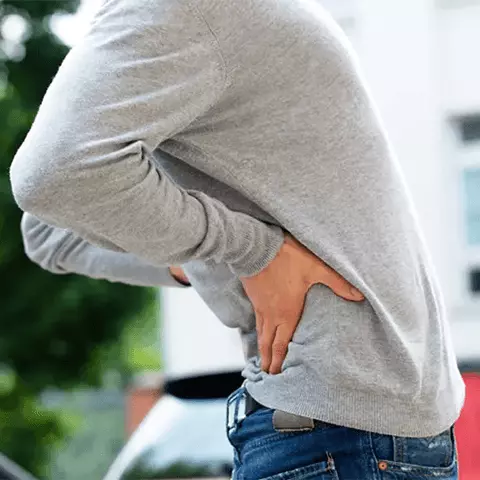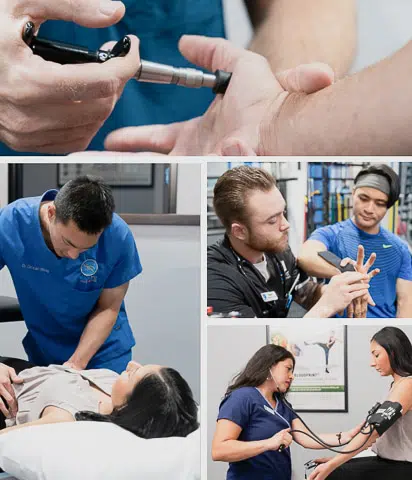Low Back Pain

Appointment Inquiries
Call us at: (877) 222-5348
Definition
A common, painful condition affecting the lower portion of the spine
Root Causes
Abnormal Spine Curvature, Ankylosing Sponylitis, Arthritis, Bulging + Herniated Discs, Fibromyalgia, Sciatica, Soft Tissue Strains, Spinal Stenosis, Spndylosis
Risk Factors
Age, Fitness Level, Genetics, Heavy Bags/Backpacks, Psychological Factors, Pushing-- Pulling-- or carrying heavy objects, Smoking, Weight
Treatments
Chiropractic, Manipulation Under Anesthesia, Physical Therapy, Spinal Decompression, TENS Therapy, Trigger Point Injections
Low back pain overview
Back pain is one of the most common reasons for people to miss work. Most low back pain starts after a sudden movement or while lifting heavy objects. One-half of all working Americans admit to having back pain symptoms each year, according to the ACA.
There are 2 types of low back pain:
- Acute pain: this short-term pain can last for a few days to a few weeks. Most low back pain falls under the category.
- Chronic pain: pain is considered chronic and long-term when it lasts longer than 12 weeks (or about 3 months). According to the National Institute of Neurological Disorders and Stroke (NINDS), about 20% of acute low back pain will become chronic low back pain.
Everyone feels pain differently. You might feel lower back pain around or in part of your waistline, in your sacrum, hip, or glutes, or into your legs. You may or may not also experience numbness and tingling in your lower extremities.
Lower back pain can also make it hard to stand up, sit straight, walk normally, and sleep.
Common causes of low back pain
While low back pain might not have an underlying cause, it can be caused by a number of underlying medical conditions including:
- Abnormal spine curvature
- Ankylosing spondylitis
- Arthritis
- Bulging or herniated disc
- Fibromyalgia
- Sciatica
- Spinal stenosis
- Soft tissue strains
- Spondylosis
Low back pain may also start with poor body mechanics, poor work ergonomics, decreased strength, muscular or structural imbalances, and pregnancy.
Risk factors of low back pain
Low back pain does not discriminate. It can affect anyone at any time. However, there are some factors that will increase the risk of getting low back pain, such as:
- Age: As we get older, the spinal vertebrae (or intervertebral discs) lose fluid and flexibility. Starting at age 30, we are all at increased risk of lower back pain, with further risk of developing spinal stenosis.
- Fitness Level: Low back pain is most common in people who are less physically active. Without regular exercise, the lower back muscles can become weak and have difficulty supporting the spine. Intermittent periods of inactivity can also increase the probability of low back pain, such as only exercising on the weekends.
- Genetics: Some genetic conditions, such as ankylosing spondylitis, can increase the chance of developing low back pain.
- Heavy bags/backpacks: Children are not immune to lower back pain. Overloaded backpacks are a major cause of back pain in kids. Adults, especially people that carry purses regularly, can also overload their bags and cause lower back pain. BackFit recommends carrying no more than 5lbs and either switch shoulders regularly or use both shoulders.
- Job factors: Work that requires lifting, pulling, or pushing heavy objects or twisting or constant vibration can especially lead to lower back pain and other injuries. Desk jobs with poor ergonomic setup are also more and more of a cause of lower back pain.
- Psychological factors: Stress influences the body in many ways. This includes increased muscle tension when under stress. Anxiety and depression can also affect tension and pain.
- Smoking: Smoking can restrict blood flow and oxygen to the vertebrae. This can cause them to degenerate earlier and faster.
- Weight: Excess weight can put pressure and stress on the lower spine especially.
Preventing low back pain
While some back pain is unavoidable, there are multiple ways to help prevent back pain from developing. Here are a few of those ways:
- Exercise regularly to keep muscles strong and flexible.
- Use ergonomically designed furniture and equipment at home and at work. Or use a pillow or rolled-up towel behind the small of your back to provide lumbar support.
- Wearing comfortable, low-heeled shoes can help maintain a more natural posture.
- Avoid heavy lifting. If you have to lift heavy objects, lift from your knees, engage your stomach muscles, and keep your neck and head in line with your back. Avoid twisting.
- Sleep on a firmer mattress on your side with your knees drawn up to prevent pressure on your spinal cord.
- Change positions regularly when sitting for long periods of time. Take regular breaks, stand up, and walk around periodically. Gently stretch before you sit back down to relieve tension and increase blood flow.
Changing up your daily habits can help prevent pain. In addition to this, regularly visiting a chiropractor can help in the prevention of low back pain.
Treatment for low back pain
Most acute back pain will get better on its own with limited bed rest, heat and/or ice, and gentle stretching. If you are still feeling pain after 72 hours, you should seek medical attention.
At BackFit, come in for a consultation, exam, and x-ray (if needed) or other imaging studies. Our providers will provide a recommended treatment plan that could include any of the following treatment options:
- Chiropractic care
- Manipulation under anesthesia
- Physical therapy
- Spinal decompression
- TENS
- Trigger point injection
Your pain relief treatment may include any or all of these and more.


